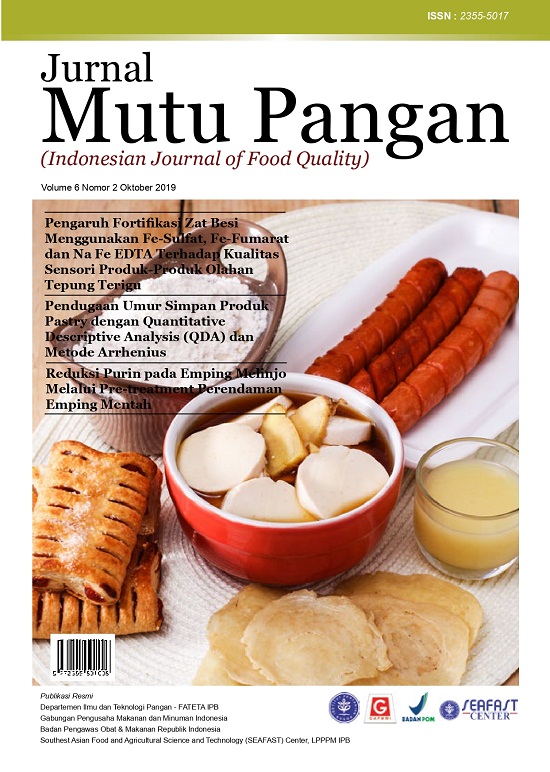Pengaruh Fortifikasi Zat Besi Menggunakan Fe-Sulfat, Fe-Fumarat dan Na Fe EDTA Terhadap Kualitas Sensori Produk-Produk Olahan Tepung Terigu
Abstract
The consumption of wheat flour in Indonesia is very high reaching 5.9 million tons during year 2016 and tends to increase steadily every year. The National Standardization Agency of Indonesia (BSN) of Wheat Flour (2009) requires the fortification with minimum iron of 50 ppm (as Fe-elemental). Study conducted byIndonesian ministry of health based on WHO recommendation (2006) states that for wheat consumption 75-149 g/day, fortificication wheat flour with iron should be as much as 60 ppm (in the form of Fe-fumarate or Fe-sulphate) or 40 ppm (in the form of NaFeEDTA compound), zinc 55 ppm (in the form of zinc oxide compound), and folic acid 2.6 ppm. The aim of this research was to evaluate the effect of fe fortification using 3 types of fe fortifcants: Ferous fumarat, Ferous sulfat and NaFeEDTA), zinc (in form of Zn oksida), vitamin B1, vitamin B2, asam folat (as premix) on sensory quality of wheat flour products such as bread, pao, cookies, noodle and macaroni. The result showed that Fe fortification using Fe-sulfat, Fe-fumarat dan Na Fe-EDTA in wheat flour did not significantly affect sensory properties of breads and pao. For cookies, NaFeEDTA slightly affect on texture (slightly harder). For noodle and macaroni, NaFeEDTA dan ferous-sulfat affect on color of productss to become darker. Overall, fe-fumarat was recommended fortificant for iron fortification of wheat flour with the lowest effect on sensory properties of wheat products.Downloads
References
Allen L, deBenoist B, Dary O, Hurrel R. 2006. Guidelines on Food Fortification with Micronutrients. World Health Organization, Food and Agricultural Organization of the United Nations. Geneva, Switerland.
Aulia SS, Rustanti N, Fitran DN. 2017. Fortifikasi nafeedta pada cookies ubi jalar kuning sebagai produk alternatif untuk menanggulangi anemia defisiensi besi. J Gizi Pangan 12(3): 161-168. DOI: 10.25182/jgp.2017.12.3.161-168.
[BSN] Bandan Standarisasi Nasional Indonesia. 2009. SNI 357: Tepung Terigu sebagai Bahan Makanan: BSN, Jakarta.
Chaudari R, Fanion M. 2008. Technical Aspects of Micronutrient Addition to Foods. Ottaway PB, editor. Food Fortification and Supplementation: Technological, Safety and Regulatory Aspects, CRC Press, Woodhead Publishing Limited, Cambridge, England.
Hurrell R, Ranum P, de Pee S, Biebinger R, Hulthen L, Johnson Q, Lynch S. 2010. Revised recommen-dations for iron fortification of wheat flour and an evaluation of the expected impact of current national wheat flour fortification programs. Food Nutr Bull 31(1): 7-21. DOI: 10.1177/15648265100311S 102.
Husna NN. 2011. Efektifitas FeSO4 dan FeSO4+ NaEDTA sebagai Fortifikan zat besi pada Susu Kedele dan Tempe. [Skripsi]. Jakarta: Fakultas Matematika dan Ilmu Pengetahuan Alam (MIPA), Universitas Indonesia.
Lotfi M, Mannar MGV, Merx RJHM, de Heuvel PN. 1996. Micronutrient Fortification of Food: Current Practice, Research, and Opportunities. International Development (IDRC), International Agriculture Centre, Ontario, Canada.
Mangalik G, Martianto D, Sukandar D. 2016. Estimasi potensi kerugian ekonomi dan biaya penanggulangan akibat anemia di indonesia. J Gizi Pangan 11(3): 237-246. DOI: 10.25182/jgp.2016.11.3.%25p.
Meilgaard MC, Civille GV, Carr BT. 2016. Sensory Evaluation Technique. CRC Press Taylor & Francis Group, Boca Raton, USA.
Uauy R, Hertrampf E, Reddy M. 2002. Iron fortification of food: overcoming, technical, practical barrier. The J Nutr. 132(4): 849-852. DOI: 10.1093/jn/132.4. 849s.

















